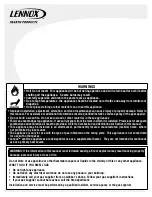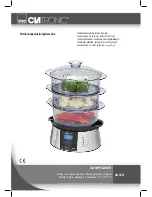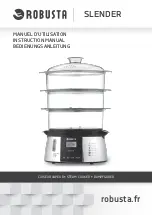
5
7.0 COMBUSTION AND VENTILATION AIR
This heater shall not be installed in a confined space or unusually tight
construction unless provisions are provided for adequate combustion and
ventilation air. The heater may be located in unusually tight construction
provided the space is unconfined, or if confined, is provided with two
permanent openings communicating directly with an additional room(s)
of sufficient volume so that the combined volume of all connected spaces
meets the criteria for an unconfined space, (National Fuel Gas Code
NFPA 54 / ANSI Z223.1 - latest edition, Section on
Air for Combustion
and Ventilation
. Generally 50 ft
3
per 1,000 BTU input of all operating
appliances in the space.
The National Fuel Gas Code, ANSI Z223.1/NFPA 54, defines a confined
space as a space whose volume is less than 50 ft
3
per 1,000 BTU/Hr
(4.8 m
3
per kW) of the aggregate input rating of all appliances installed
in that space and an unconfined space as a space whose volume is not
less than 50 ft
3
per 1,000 BTU/Hr (4.8 m
3
per kW) of the aggregate input
rating of all appliances installed in that space.
Rooms communicating directly with the space in which the appliances
are installed, through openings not furnished with doors, are considered
a part of the unconfined space.
Unusually tight construction is defined as construction where:
a. Wall and ceilings exposed to the outside atmosphere have a continu-
ous water vapor retarder with a rating of one perm (6 X 10-11 kg per
pa-sec-m
2
) or less with openings gasketed or sealed;
b. Weather stripping has been added on operable windows and doors;
and
c. Caulking or sealants are applied to areas such as joints around window
and door frames, between sole plates and floors, between wall ceiling
joints, between wall panels, at penetrations for plumbing, electrical,
and gas lines, and at other openings.
Use the following equations to determine if you have a confined or
unconfined space.
1. Determine the volume of space — ft
3
.
Length x Width x Height = _____ ft
3
(Include adjoining rooms with doorless passageways or ventilation
grills between rooms).
Example: 24' (L) x 16' (W) x 8' (H) = 3072 ft
3
. Divide the volume of space by 50 ft
3
to determine the maximum BTU/Hr
the space can support.
______ (volume of space – ft
3
)/ 50 ft
3
=
(Maximum BTU/Hr the space can support)
Example: 3072 ft
3
/ 50 ft
3
= 61.44
or 61,440 BTU/Hr the space can support.
3. Add the BTU/Hr of all the fuel burning appliances in the space.
Vent-Free heater
_______ BTU/Hr
Gas appliance #1*
_______ BTU/Hr
Gas appliance #2 +
_______ BTU/Hr
Gas appliance #3 +
_______ BTU/Hr
Total =
_______ BTU/Hr
Example:
Vent-free heater #1 9,000 BTU/Hr
Vent-free heater #2 23,000 BTU/Hr
Gas appliance #1 35,000 BTU/Hr
(water heater)
Total = 67,000 BTU/Hr
* Do not include direct-vent gas appliances. Direct-vent is sealed com-
bustion and draws combustion air from the outdoors.
4. Compare the maximum BTU/Hr the space can support with the actual
amount of BTU/Hr used.
_______ BTU/Hr (max. the space can support)
_______ BTU/Hr (actual amount of BTU/Hr used)
Example:
61,440
BTU/Hr (max. the space can support)
67,000 BTU/Hr (actual amount of BTU/Hr used)
The space in the previous example is a confined space because the
actual BTU/Hr used is more than the maximum BTU/Hr the space can
support. You must provide additional fresh air.
Your options are:
a. Rework equations adding the space of adjoining room(s). If the extra
volume provides an unconfined space, then remove door or add
ventilation grills between rooms. Refer to National Fuel Gas Code,
ANSI Z223.1/NFPA 54-latest edition, Section "Air for Combustion and
Ventilation".
b. Vent room directly to the outdoors. Refer to National Fuel Gas Code,
ANSI Z223.1/NFPA 54-latest edition, Section "Air for Combustion and
Ventilation".
c. Install a lower BTU/Hr heater to make the area an unconfined space.
If the actual BTU/Hr used is less than the maximum BTU/Hr the space
can support, then the space is an unconfined space. You will need no
additional fresh air ventilation for an unconfined space.
WARNING
If the area in which the heater may be operated is
smaller than that defined as an unconfined space or
if the building is of unusually tight construction,
provide adequate combustion and ventilation air by
one of the methods described in the national fuel
gas code, ANSI Z3.1/NFPA 54,
Air for Combustion
and Ventilation
Or applicable local codes.
Summary of Contents for Catalytic Vent-Free Wall Mounted Gas FirePlace
Page 17: ...17 30 0 NOTES...




































